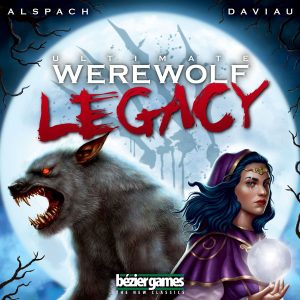Welcome to Ars Cardboard, our weekend look at tabletop games! Check out our complete board gaming coverage at cardboard.arstechnica.com.
Our 16 games of Werewolf sprawled across 20 hours and two lengthy play sessions. They began well enough, with enthusiastic people enjoying each other's company, keen to backstab, betray, and devour their fellow participants. Villagers—and the occasional werewolf—were hanged, and each persons hands were bloodied. Yes, this was the decade-old social deduction game we all knew well—but now with sealed boxes, fistfuls of stickers, and a huge leather tome for the moderator to scribble in.
Ultimate Werewolf Legacy takes an old concept and pairs it with newfangled “legacy” game mechanisms. This means components are permanently altered—mostly the moderator's diary—and decisions are made that impact future plays. In other words, it's a campaign game with irreversible decisions, promising all the drama that premise entails.
Unfortunately, it doesnt deliver.
The furry devil is in the details
If you've played Werewolf before, you know what to expect from this social deduction game. You need a minimum of eight players in addition to a dedicated moderator who runs the game—but the experience is better with more, ideally with a group of 12-16.

Each session consists of a chapter of play, with each chapter being broken down into three individual games. In each game youre dealt new roles—some of you are voracious (but hidden) werewolves, while the rest are villagers full of suspicion. Play is broken into day and night phases, with the entire group attempting to suss out the villains by day and the werewolves devouring a villager at night.
The campaign consists of five such chapters, each offering a glimpse of story courtesy of the games leather diary. The narrative itself follows a series of strange occurrences around a New England town in the late 1600s. This is the heart of the game, where players make group decisions that alter the villages path and provide consequences. Or, at least, that's the idea.
The implicit promise of a legacy game is that choices have permanence. We want our decisions to make waves that ripples throughout the campaign. Ultimate Werewolf Legacy loses sight of this principle. It has moments where you think something special is really going to happen. Some of the time it will even trick you into thinking this particular outcome will shape things drastically. (The players dont know most of this, however, as all of the stickering, note-taking, and branching paths are recorded solely by the moderator.) Feedback to players is obscured.
The single benefit to this design philosophy is increased replayability. It would be entirely reasonable to play through a campaign and then grab another copy of the game (or the recharge pack from the publisher's website) and play it again. You would indeed see new roles and a couple of small changes.
Game details
Designer: Ted Alspach, Rob Daviau
Publisher: Bezier Games
Players: 8-16
Age: 13+
Playing time: 60 minutes
Price: $42.26 (Amazon
But overall, the legacy elements here are a bit of a whiff due to their softness. Most player choices only have a very short reach. Some of the games best moments have these wild unpredictable narrative decision points full of promise—but they usually offer some bright new ability or radical option only for the next game. Then theyre gone like a horror in the dark.
For the sake of avoiding spoilers, let me fabricate an example. Before beginning play, the moderator (well, the diary) might offer a couple sentences of story concerning a villager accused of witchcraft. As a group, players must vote to cast the villager out or to declare her innocent. The outcome either adds or removes a new role to next game—although no one knows this when voting. Major decisions such as these seem like they should matter beyond modifying a single role for a single play, but thats not the case.
Even the excellent use of props is often undermined by limiting the fallout to one session. Perhaps worse, the vast majority of stickering and branching pathways alter the role selection for the next chapter only. This is almost always based on the number of team villager wins in the previous set of three scenarios. In this way, the game seeks to balance play over the long haul through incremental shifts, adjusting as it goes. An experienced moderator hoping for some agency in crafting the role-set will find no love here, as their position is reduced to directing traffic and reading the small slices of story that are scattered throughout the game (and not particularly well written).
The single mechanism that does extend over the length of the campaign is the family system. In addition to a hidden role, each player possesses a family member card which groups the player with a neighbor or two sitting nearby. This has some interesting implications for early voting, but it more importantly facilitates the “Most Valuable Villager” (MVV) system.
This game has plenty of role cards! The "family" cards. The game's narrative "diary." The introductory narrative… The game's rules booklets. Read More [contf] [contfnew] 
Ars Technica
[contfnewc] [contfnewc]







